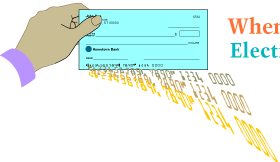
| Return to Federal Citizen Information Center Home Page |
 |
 |
|
Suppose you’re at a store making a purchase and decide to pay by check—at
least, that’s what you believe you’re doing.
|
|
The clerk asks you for a check that is completely filled out, partially
filled out, or even blank. The clerk then runs the check through a machine
and hands the voided check back to you with your receipt.
What just happened? Did you pay by check? Why did the clerk return the
check to you? The answer is, you just experienced electronic check
conversion.
The following questions and answers explain how electronic check
conversion works and what your rights are as a consumer.
|
 |
 |
|
|
Electronic check conversion is a process where your check is used as a
source of information—for the check number, your account number, and the
number that identifies your financial institution. The information is then
used to make a one-time electronic payment from your account—an electronic
fund transfer. The check itself is not the method of payment.
When you provide your check, you must be given notice that information
from your check will be used to make an electronic payment from your
account. The notice is required by the federal law that applies to
electronic fund transfers—the Electronic Fund Transfer Act and the Federal
Reserve Board’s Regulation E. Notice may be provided in different ways.
For example, a merchant may post a sign at the register or may give you a
written notice that you’ll be asked to sign.
Always review your regular account statement from your financial
institution. You should immediately contact your financial institution if
you see a problem. Were you charged the wrong amount? Were you charged
twice for the same transaction? You have only 60 days (from the date your
statement was sent) to tell the financial institution about the problem.
Depending on the circumstances, the financial institution may take up to
45 days from the time you notify it to complete its investigation.
No. An electronic check conversion transaction is a one-time electronic
payment from your account. If you were to use the same check for more than
one transaction and you had a problem with one of the transactions, your
financial institution might have difficulty investigating the problem
because the same check number would appear more than once on your
statement.
Yes. For example, let’s assume that each time you get your insurance bill
there is a notice. It tells you that when you mail a check, information
from that check will be used to make an electronic payment from your
account. If you then send a check, you have agreed to electronic check
conversion. Unlike what happens when you make a purchase at a store,
however, you won’t receive a receipt. Your check won’t be returned to you
with your account statement from your financial institution because the
transaction was processed as an electronic fund transfer, not as a check
transaction.
As with electronic check conversions in stores, be sure you have enough
money in your account when you mail your check, keep records of your
payments, and check your account statements from your financial
institution to make sure the amounts charged are correct.
If you don’t want your check to be used for electronic check conversion,
you may have to provide another form of payment (for example, cash, debit
card, or credit card).
Contact your financial institution directly. For information on state laws
that may apply to electronic check conversion, contact your state’s
consumer protection agency or attorney general’s office.
Contact:
Federal Trade Commission
Consumer Response Center 600 Pennsylvania Ave., NW Washington, DC 20580
877-FTC-HELP — toll free (877-382-4357)
Please also send a copy of your complaint to:
Board of Governors of the Federal Reserve System
Division of Consumer and Community Affairs Washington, DC 20551
202-452-3693
www.federalreserve.gov
Before you agree to electronic check conversion, you should first ask
yourself
Before you leave the store, you should ask yourself
When you receive your statement from your financial institution, you
should
|
| Return to Federal Citizen Information Center Home Page |